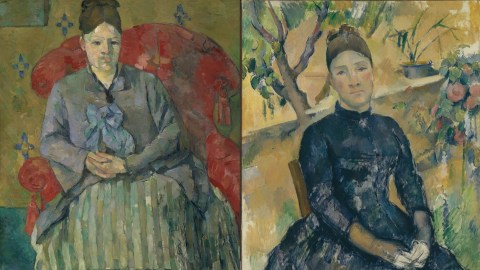Madame Cézanne: The Case of the Miserable Muse

If Mona Lisa is the smile, Madame Cézanne is the scowl. Hortense Fiquet, Paul Cézanne’s model turned mistress turned mother of his child turned metaphorical millstone around his neck, endures as a standard art history punch line—the muse whose misery won immortality through the many masterpiece portraits done of her. Or at least that’s how the joke usually goes. The Metropolitan Museum of Art’s current exhibition Madame Cézanne, which gathers together 24 of the 29 known portraits Cézanne painted of Hortense over a period of more than 20 years, tries to rewrite that joke as it hopes to solve the riddle of Madame Cézanne, aka, The Case of the Miserable Muse.
After studying law but actually wishing to become an artist, Paul Cézanne, egged on to defy his father by close friend and future novelist Émile Zola, left his native Aix for Paris in 1861 to begin his artistic career. Cézanne’s father (immortalized himself later in a portrait in which Paul placed a liberal newspaper in his conservative father’s hands) eventually accepted his son’s choice and provided financial support. Sometime in 1869, Cézanne met and began painting Hortense at a Parisian art school where she worked both as a bookbinder and model. By July 1870, they were not just lovers, but lovers on the lam, as Paul fled Paris with his mistress to dodge the draft for the Franco-Prussian War.
After the war’s end, the lovers returned to Paris by the summer of 1871, where their son Paul would be born out of wedlock in January of 1872. Knowing that his father would not accept his mistress or their son, Cézanne kept both a secret from his father (but felt secure enough to tell his mother). Cézanne’s father found out about his son’s living arrangements in 1878, raged for an acceptable period, but eventually increased his financial support to keep the new family afloat in the house Hortense kept in the suburbs of Paris as Paul more and more frequently commuted to Paris to pursue his art.
Nearly two decades after meeting, Hortense and Paul officially married on April 28, 1886, before the patient and presumably appreciative gaze of Cézanne’s parents. Sadly, by that time, Cézanne seems to have lost all affection for Hortense, at least judging from comments that have passed down in history such as, “My wife only cares for Switzerland and lemonade.” Cézanne went so far as to move out of their home and to live with his mother and sister after his long-suffering father’s death in 1886, the same year as his marriage to Hortense.
Also in that fateful year of 1886, Cézanne’s friend Zola published a fictional account of the artist in the novel L’Œuvre. Zola’s stand-in for Cézanne, Claude Lantier, also marries his model-mistress, renamed Christine Hallegrain, who also rises from mistress to model to mother, but the fictional son dies. Zola stirs in details from the lives and works of Édouard Manet and Claude Monet into Claude Lantier, but the central element of the tortured artist whose genius is only recognized posthumously is clearly a nod toward the still-living, still-unrecognized Cézanne. The fictional Christine poses nude for her lover-genius and is allowed some moments of interior life, which seems a jarring departure from the buttoned-down, enigmatically silent portraits we typically think of by Cézanne of Madame Cézanne. Did Zola know more then than we know now?
Despite this physical and emotional separation after 1886, Cézanne continued to paint Madame Cézanne well into the 1890s. When Cézanne died in 1906, he disinherited Hortense and left everything to their son Paul. Legend holds that the fashion-obsessed Hortense failed to reach her husband’s deathbed in time because of an appointment with a dressmaker. Despite outliving Cézanne by 16 years, Hortense failed to have the last word with art historians and critics, who relied on the perhaps unreliable testimony of family and friends who never accepted her as the artist’s life partner. Thus, the painted scowl became the accepted persona of Hortense, who, despite living well into the 20th century, found herself categorized as a voiceless stereotype of the scowling shrew just as the 16th century Mona Lisa’s become a voiceless stereotype of the smiling enchantress.
Madame Cézanne may not give the real Madame Cézanne her true voice back, but it does give us an opportunity to reevaluate her, her husband, and their relationship through his work. Cézanne’s infamously slow, methodical approach to painting ripened and rotted fruit and withered flowers before his eyes. Family members endured long sitting sessions that would have tried the patience of saints. Only the monumental patience of Mont Sainte-Victoire—literally a motionless mountain—could match Cézanne’s own endurance before a canvas. (The artist died of illness after painting outdoors in a soaking rain for hours, a sign of his dedication and/or foolishness.) You don’t find smiles on any of Cézanne’s sitter’s faces, so why does Hortense get such a bad reputation?
Perhaps it is in sheer numbers of images. After himself, Cézanne’s favorite portrait subject was his life partner. The Met reunites a remarkable array of portraits scattered across the globe over the years with their own collection’s Madame Cézanne in a Red Dress (1888–90) and Madame Cézanne in the Conservatory (1891). Two portraits that provide a neat contrasts in time, style, and content are Madame Cézanne in a Red Armchair (circa 1877, from the Museum of Fine Arts, Boston; shown above left) and the Met’s Madame Cézanne in the Conservatory (1891; shown above right).
In the earlier painting, Hortense serves simply as a delivery system for the interesting patterns of her clothing, especially her striped skirt. The colors of her clothes also complement the wallpaper behind her, while also contrasting against the titular red chair. Hortense herself looks to the side, away from the viewer (and artist). Deep blue shadows on her face add to the scowling illusion. In the later painting, however, Cézanne brings Hortense outside into the sunlight. Her simpler dark clothes make her pop out in contrast to the bright yellows of the conservatory behind her. She meets eye of the viewer (and artist) directly with her eye. You can’t call her expression a smile, but I don’t see a scowl there, either. Whereas in 1877 Cézanne painted a person as a means towards the end of exhibiting his unique style, in 1891 Cézanne paints a person as the end, with the style serving content, rather than the other way around.
Yet, according to Cézanne’s own comments and the historical record, the portraits should be going in the opposite direction of greater and greater alienation. The scowl should be getting worse, not better. The exhibition includes two of my favorite portraits of Madame Cézanne from the collection of the Philadelphia Museum of Art, owners of perhaps the finest Cézanne collection in the United States. In one dated around 1885 to 1887, Cézanne focuses tightly on Hortense’s face, with only a hint of greenery on the periphery to suggest a garden setting. Depicted more photographically than usual for Cézanne, Hortense’s eyes look up and away, suggesting intense thought, and her upraised chin raises the expectation of her answering some kind of question—both visual signs of a inner life that Cézanne and consequent art history usually don’t ascribe to Madame Cézanne.
In an unfinished, early 1890s portrait also from Philadelphia that may have been Cézanne’s last of Hortense, Cézanne paints her with her hair physically and symbolically down. She looks away, but the effect isn’t of cool distance but rather of warm longing, thus inviting you to empathize with her as she mentally imagines what was or what could have been. Part of the severity of the “classic” Madame Cézanne look is her hair in a severe bun, which completes the effect of the oval face that first fascinated Cézanne in Hortense as a model. By loosening that constriction and allowing Hortense’s hair to flow down her shoulders, Cézanne turns the oval into a triangle, perhaps echoing his favorite triangular model, Mont Sainte-Victoire, that emblem of permanence and perseverance. In this final portrait, painted when Paul was distancing himself and even disinheriting Hortense, is the artist acknowledging that Madame Cézanne was the “rock” that kept him anchored all those years?
Critics, most notably Meyer Schapiro, write off these more personalized portraits of Madame Cézanne as the artist projecting his own thoughtfulness or longing onto his mate’s features, as if the very idea of Hortense having an inner life is inconceivable. But what if the real projection on the part of Paul Cézanne was the scowling portraits? Faced with critical and commercial rejection of his ground-breaking approach to painting, did Cézanne project his frustrations onto the face of Hortense as a way of disguising yet displaying his dismay?
We’ll most likely never know for sure, but this exhibition at least raises the question of just how objective Cézanne was in depicting this woman who stood beside him in thick and thin for decades as she was kept secret from his family and rejected even more after the secret was out. Can we ever recapture the more human side of Hortense and her relationship with Cézanne that we see in such paintings as 1872’s Hortense Breast Feeding Paul, not only a full-bodied nude that harks back to her role as model, but also a domestic scene of her with their son that both captures the present beautifully but looks hopefully to their future together? As the song goes, you always hurt the one you love, so the takeaway of this exhibition might be that mixture of love and injury literally painted on Madame Cézanne’s face by Cézanne over the course of their tempestuous lives together.
Near the end of Zola’s L’Œuvre, the fictional artist struggles to paint his masterpiece—a picture of Paris centered upon a grand nude for which Christine models. When the artist fails to achieve his vision he turns viciously upon Christine and blames the painting’s failure upon her failure to model as the grand nude. Time takes its toll on Christine. Her sagging flesh, the artist argues, sabotages his success as a painter. “Not very lovely, is it?” the painter remarks after directing Christine to look in a mirror. Zola perhaps knew Cézanne better than anyone (other than Madame Cézanne, of course), so we can’t dismiss the novel’s suggestions too quickly. It’s easy to look at the works presented in the exhibition Madame Cézanne and say, “Not very lovely, is it?” What’s harder is to give Hortense a fair hearing and to judge the source of any perceived ugliness in the portraits. Because that source will never be conclusively found, the case of Madame Cézanne, the miserable muse, will never be closed.
[Image:Paul Cézanne (French, Aix-en-Provence 1839–1906 Aix-en-Provence). (LEFT) Madame Cézanne in a Red Armchair, About 1877. Oil on canvas, 72.4 x 55.9 cm (28 1/2 x 22 in.). Museum of Fine Arts, Boston. (RIGHT) Madame Cézanne (Hortense Fiquet, 1850–1922) in the Conservatory, 1891. Oil on canvas, 36 1/4 x 28 3/4 in. (92.1 x 73 cm). The Metropolitan Museum of Art, Bequest of Stephen C. Clark, 1960.]
[Many thanks to The Metropolitan Museum of Art, New York, for providing me with the images above and other press materials related to the exhibition Madame Cézanne, which runs through March 15, 2015.]
[Please follow me on Twitter (@BobDPictureThis) and Facebook (Art Blog By Bob) for more art news and views.]




